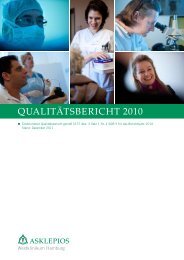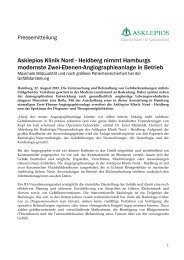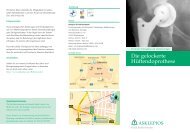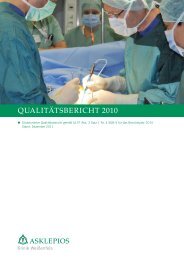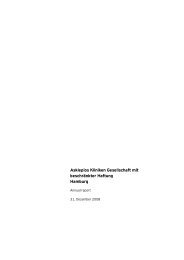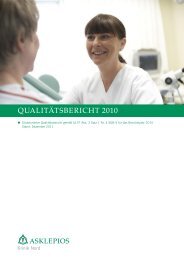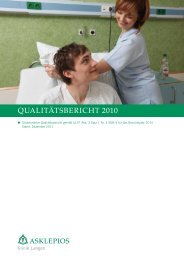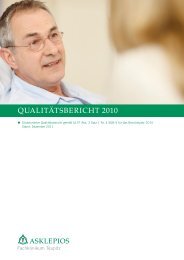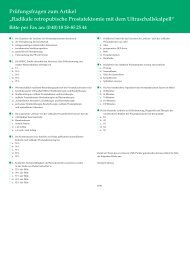Download Sammelmappe - Asklepios
Download Sammelmappe - Asklepios
Download Sammelmappe - Asklepios
Erfolgreiche ePaper selbst erstellen
Machen Sie aus Ihren PDF Publikationen ein blätterbares Flipbook mit unserer einzigartigen Google optimierten e-Paper Software.
Intel is working with leading health care organizations that have an understanding of health<br />
care delivery to develop customizable protocols, as well as multimedia educational content for<br />
chronic conditions. In the UK, the Intel Health Guide offers template protocols developed by<br />
the Map of Medicine, an organization devoted to developing and promoting evidence-based<br />
clinical information. These protocols are based on national best practice guidelines and can be<br />
customized to meet local requirements. In the US, Intel is working with industry associations<br />
and clinical leaders to develop similar protocols. Major healthcare organizations that have a<br />
deep understanding of healthcare delivery are using Intel’s authoring tools to develop unique<br />
protocols as well as educational content for chronic illnesses.<br />
Benefits of Remote Patient Monitoring<br />
Remote patient monitoring has been shown to facilitate better patient management, leading to<br />
more cost-effective care. While further, long-term studies are needed, a growing body of<br />
evidence indicates that RPM is associated with a range of benefits in the care of patients with<br />
long-term conditions.<br />
Note that the studies discussed below used telehealth devices other<br />
than the Intel Health Guide. Intel is collaborating with healthcare<br />
organizations to demonstrate the value of the Intel Health Guide.<br />
US Department of Veterans Affairs<br />
In December 2008, the US Department of Veterans Affairs described its success in incorporating<br />
telehealth into a large-scale, evidence-based care coordination program. 8 Introduced in July<br />
2003, the Veterans Health Administration’s Care Coordination/Home Telehealth (CCHT)<br />
program grew from 2,000 patients to more than 31,500 by December 2007, serving patients who<br />
are largely 65 years and older and suffering from diabetes, heart failure, hypertension, post<br />
traumatic stress disorder, COPD, and/or depression or other mental health conditions. Thirtysix<br />
percent of patients were monitored for multiple conditions. Among the VHA’s results:<br />
� A 25 percent drop in bed days of care<br />
� A 19 percent decline in numbers of hospital admissions<br />
� Mean satisfaction of 86 percent among patients after enrollment into the program<br />
The cost of the program is $1,600 per patient per year – “substantially less” than other noninstitutional<br />
care programs, according to the authors. The authors conclude, “VHA’s experience<br />
is that an enterprise-wide home telehealth implementation is an appropriate and cost-effective<br />
way of managing chronic care patients in both urban and rural settings.” The VHA plans to<br />
extend and expand the program based on the successes already experienced.<br />
Noel et al and Meyer, Kobb and Ryan<br />
Noel et al9 and Meyer, Kobb and Ryan10 have studied the use of telemedicine for patients with<br />
chronic diseases, and found that RPM helped to:<br />
8 Darkins, et al, Care Coordination/Home Telehealth: The Systematic Implementation of Health Informatics, Home<br />
Telehealth, and Disease Management to Support the Care of Veteran Patients with Chronic Conditions, Telehealth<br />
and e-Health, Dec. 2008, http://www.liebertonline.com/toc/tmj/14/10<br />
9 Noel et al, Home Telehealth Reduces Healthcare Costs, Telemedicine Journal and e-Health, Vol. 10, No.2, 2004<br />
Clinical Application Notes RSLT-A-0495, Rev 1.0, Effective March 27, 2009 Medd/Rowell - Page 4



